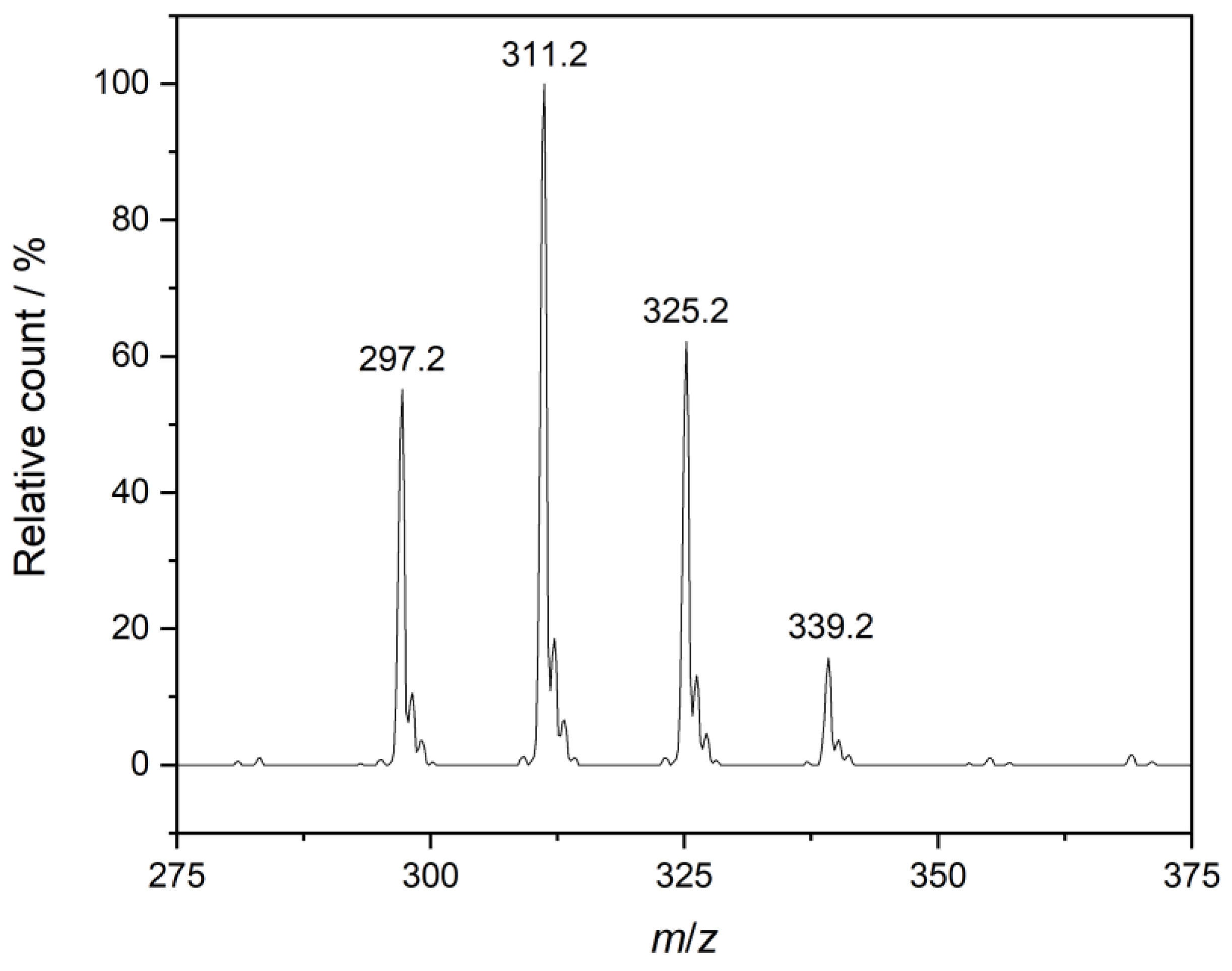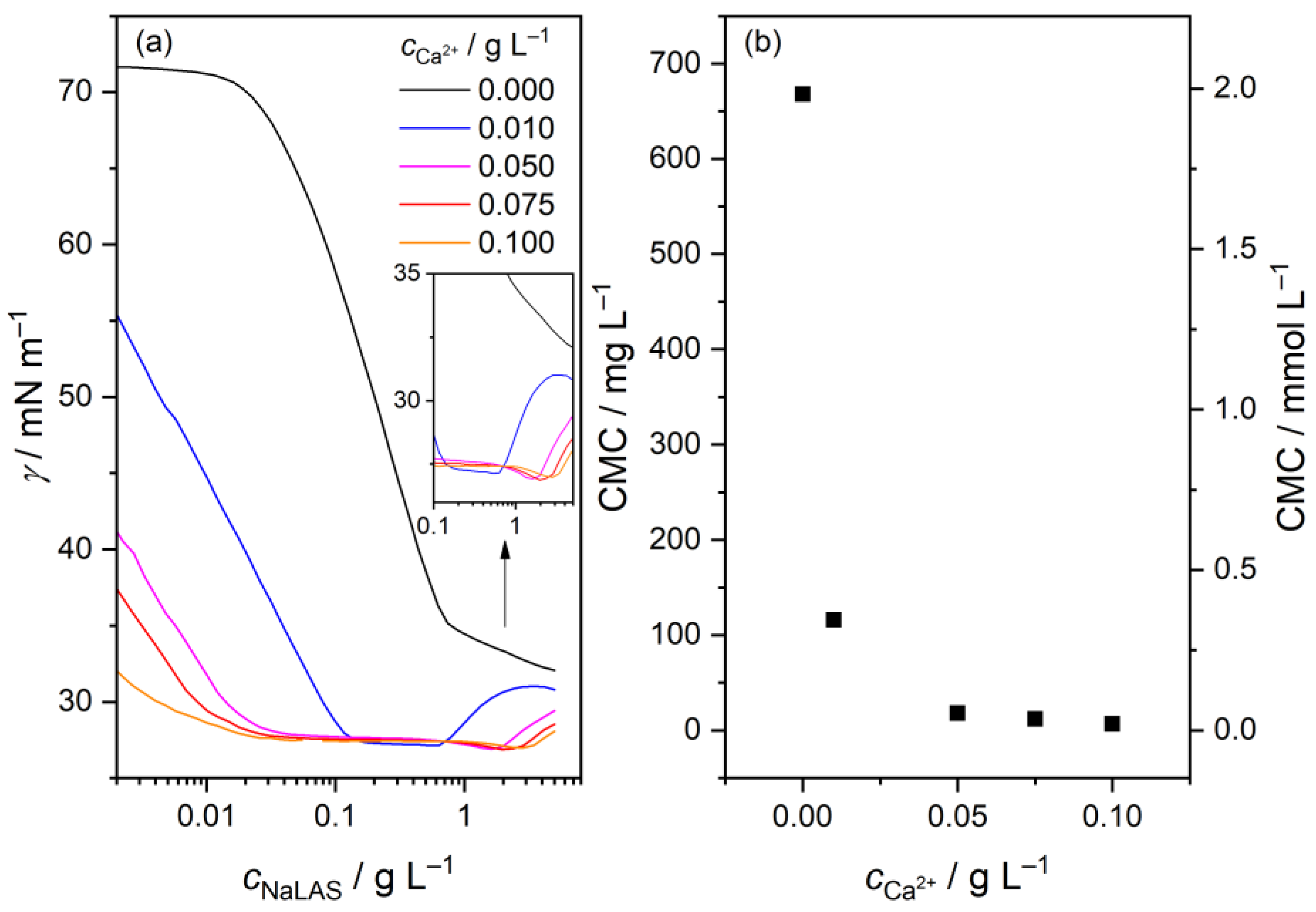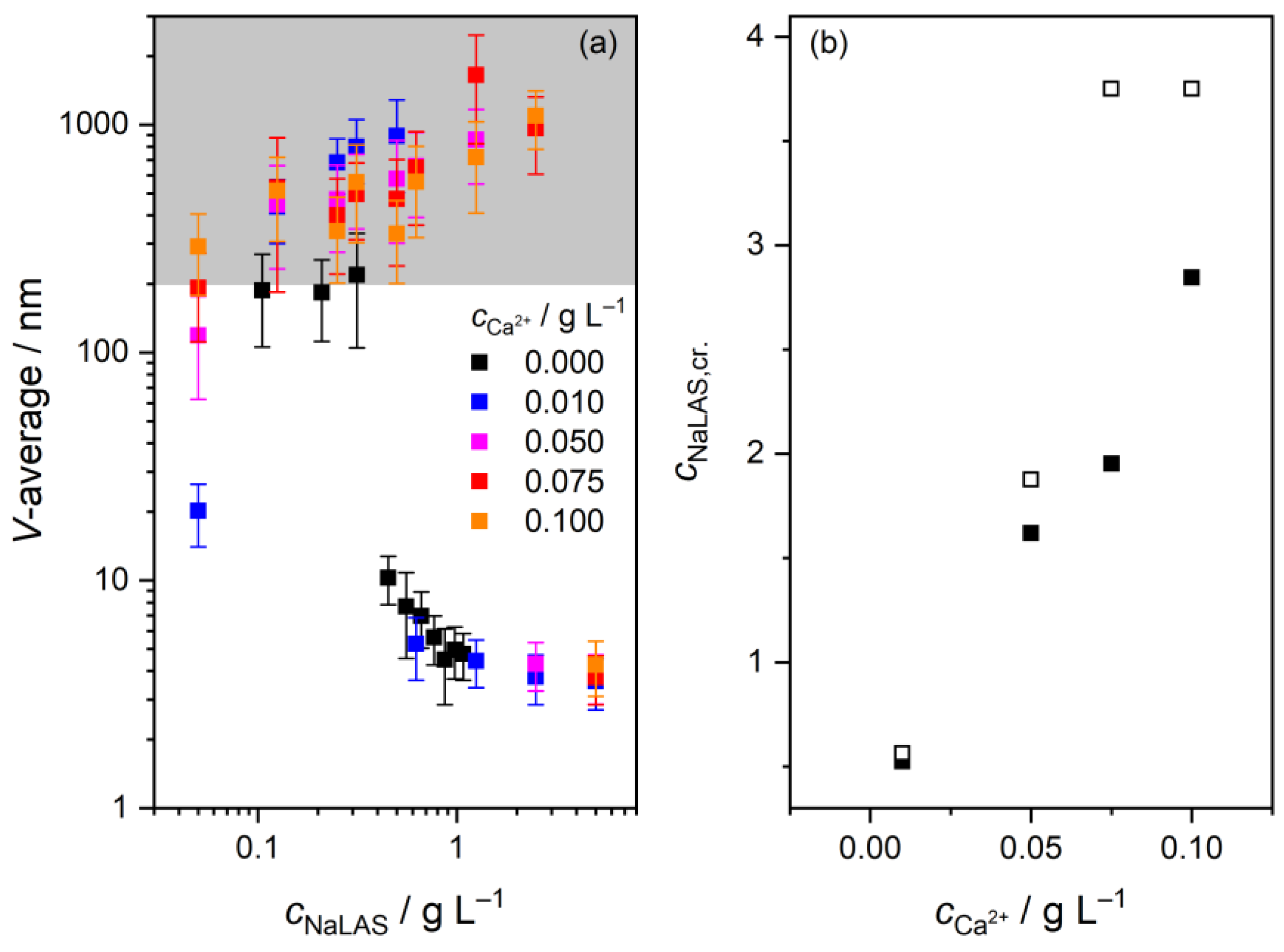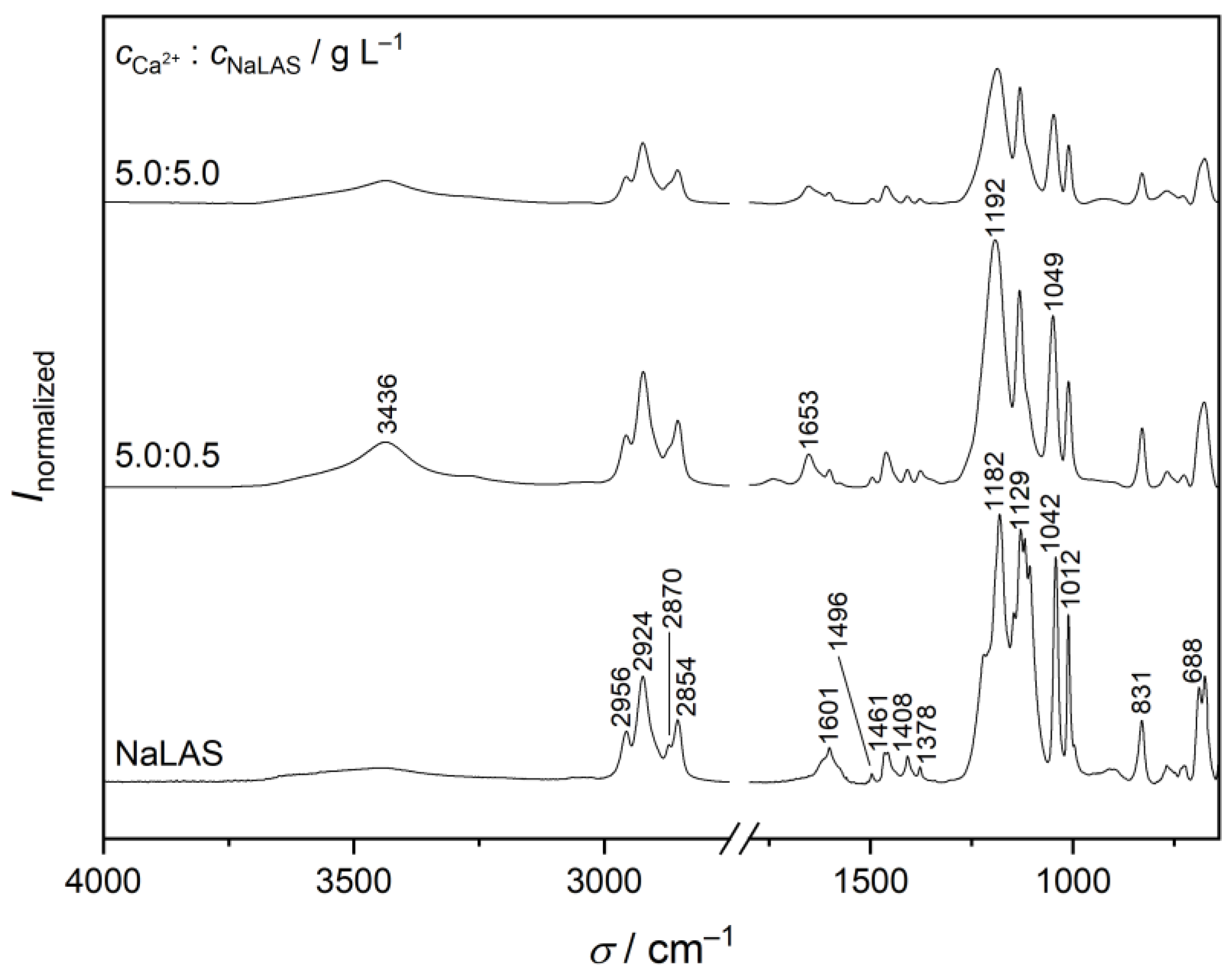Binding of Ca2+ Ions to Alkylbenzene Sulfonates: Micelle Formation, Second Critical Concentration and Precipitation
Abstract
1. Introduction
2. Materials and Methods
2.1. Materials
2.2. Preparation of Aqueous Samples and Precipitates
2.3. Experimental Methods
3. Results and Discussion
3.1. Variation of the Surface Tension and CMC in the Colloidal Regime
3.2. Variation of the Average Particle Size at the Precipitation Boundary
3.3. Characterization of the Precipitates
4. Conclusions
Supplementary Materials
Author Contributions
Funding
Institutional Review Board Statement
Informed Consent Statement
Data Availability Statement
Acknowledgments
Conflicts of Interest
References
- Negin, C.; Ali, S.; Xie, Q. Most common surfactants employed in chemical enhanced oil recovery. Petroleum 2007, 3, 197–211. [Google Scholar] [CrossRef]
- Hirasaki, G.; Miller, C.A.; Puerto, M. Recent advances in surfactant EOR. SPE J. 2011, 16, 889–904. [Google Scholar] [CrossRef]
- Scott, M.J.; Jones, M.N. The biodegradation of surfactants in the environment. Biochim. Biophys. Acta Biomembr. 2000, 1508, 235–251. [Google Scholar] [CrossRef] [PubMed]
- Mukerjee, P.; Mysels, K.J. Critical Micelle Concentrations of Aqueous Surfactant Systems; National Standard Reference Data Series; National Bureau of Standards: Washington, DC, USA, 1970; Volume 36, p. 56.
- Zhu, X. Studies of Sodium Dodecylbenzenesulfonate-Water-Electrolyte Interactions. Master’s Thesis, Eastern Illinois University, Charleston, SC, USA, 1986. [Google Scholar]
- Hait, S.K.; Majhi, P.R.; Blume, A.; Moulik, S.P. A Critical assessment of micellization of sodium dodecyl benzene sulfonate (SDBS) and its interaction with poly(vinyl pyrrolidone) and hydrophobically modified polymers, JR 400 and LM 200. J. Phys. Chem. B 2003, 107, 3650–3658. [Google Scholar] [CrossRef]
- Dubey, N. thermodynamic properties of micellization of sodium dodecylbenzene sulfonate in the aqueous-rich region of 1-pentanol and 1-hexanol. J. Chem. Eng. Data 2009, 54, 1015–1021. [Google Scholar] [CrossRef]
- Zhang, J.; Qiu, Y.; Yu, D.-Y. Critical micelle concentration determination of sodium dodecyl benzene sulfonate by synchronous fluorescence spectrometry. Chin. J. Appl. Chem. 2009, 26, 1480–1483. [Google Scholar]
- Reziqat, I.A.-D.M. Effect of Temperature and Added Salts on the Critical Micelle Concentration (CMC) and Some Thermodynamic Variables of Sodium Dodecyl Benzene Sulphonate Solutions. Master’s Thesis, Hebron University, Hebron, Palestine, April 2018. [Google Scholar]
- Shi, Y.; Luo, H.Q.; Li, N.B. Determination of the critical premicelle concentration, first critical micelle concentration and second critical micelle concentration of surfactants by resonance Rayleigh scattering method without any probe. Spectrochim. Acta A 2011, 78, 1403–1407. [Google Scholar] [CrossRef]
- Chauhan, S.; Sharma, K. Effect of temperature and additives on the critical micelle concentration and thermodynamics of micelle formation of sodium dodecyl benzene sulfonate and dodecyltrimethylammonium bromide in aqueous solution: A conductometric study. J. Chem. Thermodyn. 2014, 71, 205–211. [Google Scholar] [CrossRef]
- Sood, A.K.; Aggarwal, M. Evaluation of micellar properties of sodium dodecylbenzene sulphonate in the presence of some salts. J. Chem. Sci. 2018, 130, 39. [Google Scholar] [CrossRef]
- Anachkov, S.E.; Tcholakova, S.; Dimitrova, D.T.; Denkov, N.D.; Subrahmaniam, N.; Bhunia, P. Adsorption of linear alkyl benzene sulfonates on oil–water interface: Effects of Na+, Mg2+ and Ca2+ ions. Colloids Surf. A 2015, 466, 18–27. [Google Scholar] [CrossRef]
- Amani, P.; Miller, R.; Ata, S.; Hurter, S.; Rudolph, V.; Firouzi, M. Dynamics of interfacial layers for sodium dodecylbenzene sulfonate solutions at different salinities. J. Ind. Eng. Chem. 2020, 92, 174–183. [Google Scholar] [CrossRef]
- Vera, R.E.; Salazar-Rodríguez, F.; Marquez, R.; Forgiarini, A.M. How the influence of different salts on interfacial properties of surfactant–oil–water systems at optimum formulation matches the Hofmeister series ranking. J. Surfactants Deterg. 2020, 23, 603–615. [Google Scholar] [CrossRef]
- Pipatpongsanon, P.; Wannakomol, A. Using linear alkyl benzene sulfonate to reduce interfacial tension of crude oil. Suranaree J. Sci. Technol. 2012, 19, 93–97. [Google Scholar]
- Tan, J.; Shen, Y.; Lai, X.; Wang, L.; Li, H.; Liu, S. Performance evaluation and application of the surfactant combinations showing ultra-low oil-water interfacial tensions. Tenside Surfactants Deterg. 2018, 55, 65–70. [Google Scholar] [CrossRef]
- Zhao, S.; Zhou, Z.-H.; Snagguan, Y.-N.; Han, L.; Wang, L.-L.; Fan, W.; Zhang, Q.; Zhang, L.; Ma, G.-Y.; Zhang, L. Effect of bivalent cations on the interfacial tensions of extended anionic surfactant solutions. J. Mol. Liq. 2022, 349, 118162. [Google Scholar] [CrossRef]
- Shupe, R.D.; Maddox, J., Jr. Surfactant Oil Recovery Process Usable in High Temperature Formations Containing High Salinity Water; Texaco, Inc.: New York, NY, USA, 1978. [Google Scholar]
- Bansal, V.K.; Shah, D.O. The effect of addition of ethoxylated sulfonate on salt tolerance, optimal salinity, and impedance characteristics of petroleum sulfonate solutions. J. Colloid Interface Sci. 1978, 65, 451–458. [Google Scholar] [CrossRef]
- Belhaj, A.F.; Elraies, K.A.; Mahmood, S.M.; Zulkifli, N.N.; Akbari, S.; Hussien, O.S. The effect of surfactant concentration, salinity, temperature, and pH on surfactant adsorption for chemical enhanced oil recovery: A review. J. Pet. Explor. Prod. Technol. 2020, 10, 125–137. [Google Scholar] [CrossRef]
- Illous, E.; Ontiveros, J.F.; Lemahieu, G.; Lebeuf, R.; Aubry, J.-M. Amphiphilicity and salt-tolerance of ethoxylated and propoxylated anionic surfactants. Colloids Surf. A 2020, 601, 124786. [Google Scholar] [CrossRef]
- Gang, H.-Z.; He, X.; He, X.; Bao, X.; Liu, J.; Yang, S.; Li, Y.; Mu, B.-Z. Interfacial properties and salt tolerance of carboxylated nonylphenol ethoxylate surfactants. Colloids Surf. A 2021, 615, 126222. [Google Scholar] [CrossRef]
- Figdore, P.E. Adsorption of surfactants on kaolinite: NaCl versus CaCl2 salt effects. J. Colloid Interface Sci. 1982, 87, 500–517. [Google Scholar] [CrossRef]
- Mannhardt, K.; Schramm, L.L.; Novosad, J.J. Effect of rock type and brine composition on adsorption of two foam-forming surfactants. SPE Adv. Technol. Ser. 1993, 1, 212–218. [Google Scholar] [CrossRef]
- Muhammad, R.A.; Isa, M.T.; Lukman, I.; Muhammad, M.; Muhammad, N.; Muhammad, S. Static adsorption of anionic surfactant onto crushed Berea sandstone. J. Pet. Explor. Prod. Technol. 2013, 3, 195–201. [Google Scholar]
- Lau, H.C.; O’Brien, S.M. Surfactant transport through porous media in steam-foam processes. SPE Res. Eng. 1988, 3, 1177–1185. [Google Scholar] [CrossRef]
- Xu, Q.; Nakajima, M.; Ichikawa, S.; Nakamura, N.; Roy, P.; Okadome, H.; Shiina, T. Effect of surfactant and electrolyte concentration on bubble formation and stabilization. J. Colloid Interface Sci. 2009, 332, 208–214. [Google Scholar] [CrossRef] [PubMed]
- Majeed, T.; Solling, T.I.; Kamal, M.S. Foam stability: The interplay between salt-, surface- and critical micelle concentration. J. Pet. Sci. Eng. 2020, 187, 106871. [Google Scholar] [CrossRef]
- Shinoda, K. The effect of chain length, salts and alcohols on the critical micelle concentration. Bull. Chem. Soc. Jpn. 1953, 26, 101–105. [Google Scholar] [CrossRef]
- Chung, J.J.; Lee, S.W.; Choi, J.H. Salt effects on the critical micelle concentration and counterion binding of cetylpiridinium bromide micelles. Bull. Korean Chem. Soc. 1991, 12, 411–413. [Google Scholar]
- Noll, L.A. The Effect of Temperature, Salinity, and Alcohol on the Critical Micelle Concentration of Surfactant. In Proceedings of the SPE International Symposium on Oilfield Chemistry, Anaheim, CA, USA, 20–22 February 1991. [Google Scholar]
- Oya, M.; Takemoto, Y.; Ishikawa, Y. Large decrease in acute toxicity of linear alkylbenzene sulfonate in hard water and seawater by adding adsorbent. J. Oleo Sci. 2008, 57, 15–21. [Google Scholar] [CrossRef]
- Rafique, A.S.; Khodaparast, S.; Poulos, A.S.; Sharratt, W.N.; Robles, E.S.J.; Cabral, J.T. Micellar structure and transformations in sodium slkylbenzenesulfonate (NaLAS) aqueous solutions: Effects of concentration, temperature, and salt. Soft Matter 2020, 16, 7835–7844. [Google Scholar] [CrossRef]
- Amani, P.; Firouzi, M. Effect of divalent and monovalent salts on interfacial dilational rheology of sodium dodecylbenzene sulfonate solutions. Colloids Interfaces 2022, 6, 41. [Google Scholar] [CrossRef]
- Sammalkorpi, M.; Karttunen, M.; Haataja, M. Ionic surfactant aggregates in saline solutions: Sodium dodecyl sulfate (SDS) in the presence of excess sodium chloride (NaCl) or calcium chloride (CaCl2). J. Phys. Chem. B 2009, 113, 5863–5870. [Google Scholar] [CrossRef] [PubMed]
- Hofmeister, F. Zur Lehre von der Wirkung der Salze. Arch. Exp. Pathol. Pharmakol. 1888, 24, 247–260. [Google Scholar] [CrossRef]
- Somasundran, P.; Celik, M.; Goyal, A.; Manev, E. The role of surfactant precipitation and redissolution in the adsorption of sulfonate on minerals. SPE J. 1984, 24, 233–239. [Google Scholar] [CrossRef]
- Noïk, C.; Bavière, M.; Defives, D. Anionic surfactant precipitation in hard water. J. Colloid Interface Sci. 1987, 115, 36–45. [Google Scholar] [CrossRef]
- Al-Hashim, H.S.; Celik, M.S.; Oskay, M.M.; Al-Yousef, H.Y. Adsorption and precipitation behaviour of petroleum sulfonates from Saudi Arabian limestone. J. Pet. Sci. Eng. 1998, 1, 335–344. [Google Scholar] [CrossRef]
- Chattopadhyay, A.K.; Gaicha, L.; Oh, S.G.; Shah, D.O. Salt effects on monolayers and their contribution to surface viscosity. J. Phys. Chem. 1992, 96, 6509–6513. [Google Scholar] [CrossRef]
- Algoul, T.S.; Sengupta, S.; Bui, T.T.; Velarde, S. Tuning the surface ordering of self-assembled ionic surfactants on semiconducting single-walled carbon nanotubes: Concentration, tube diameter, and counterions. Langmuir 2018, 34, 9279–9288. [Google Scholar] [CrossRef]
- Bergström, L.M. A theoretical investigation of the influence of the second critical micelle concentration on the solubilization capacity of surfactant micelles. AIP Adv. 2018, 8, 055136. [Google Scholar] [CrossRef]
- Arkhipov, V.P.; Kuzina, N.A.; Filippov, A. self-diffusion coefficients, aggregation numbers and the range of existence of spherical micelles of oxyethylated alkylphenols. Appl. Magn. Reson. 2021, 52, 607–617. [Google Scholar] [CrossRef]
- Almgren, M.; Grimel, J.C.; Wang, K.; Karlsson, G.; Edwards, K.; Brown, W.; Mortensen, K. SDS micelles at high ionic strength. A light scattering, neutron scattering, fluorescence quenching, and cryoTEM investigation. J. Colloid Interface Sci. 1998, 202, 222–231. [Google Scholar] [CrossRef]
- Saha, A.; Mal, A.; Ghosh, S. An elaborate investigation on the transition of rod-like micelle of cetyltrimethylammonium p-toluenesulfonate in presence of different additives. J. Mol. Liq. 2020, 309, 113084. [Google Scholar] [CrossRef]
- Alargova, R.; Petkov, J.; Petsev, D.; Ivanov, I.B.; Broze, G.; Mehreteab, A. Light scattering study of sodium dodecyl polyoxyethylene-2-sulfate micelles in the presence of multivalent counterions. Langmuir 1995, 11, 1530–1536. [Google Scholar] [CrossRef]
- Alargova, R.G.; Danov, K.D.; Petkov, J.T.; Kralchevsky, P.A.; Broze, G.; Mehreteab, A. Sphere-to-Rod Transition in the Shape of Anionic Surfactant Micelles Determined by Surface Tension Measurements. Langmuir 1997, 13, 5544–5551. [Google Scholar] [CrossRef]
- Gerbacia, W.E.F. Calcium dodecyl sulfate precipitation from solutions containing sodium chloride. J. Colloid Interface Sci. 1983, 93, 556–559. [Google Scholar] [CrossRef]
- Elgquist, B.; Wedborg, M. Stability of the calcium sulphate ion pair at the ionic strength of seawater by potentiometry. Mar. Chem. 1979, 7, 273–280. [Google Scholar] [CrossRef]
- Hefter, G.; Marcus, Y. Ion Pairing. Chem. Rev. 2006, 106, 4585–4621. [Google Scholar]
- Liu, Z.-H.; Fan, C.-C.; Zhan, T.-T.; Ji, X.-J.; Cheng, S.-H.; Sun, S.-Q.; Hu, S.-Q. Density functional theory study of the interaction between sodium dodecylbenzenesulfonate and mineral cations. Acta Phys. Chim. Sin. 2016, 32, 445–452. [Google Scholar] [CrossRef]
- Cheng, D.C.H.; Gulari, E. Micellization and intermicellar interactions in aqueous sodium dodecyl benzene sulfonate solutions. J. Colloid Interface Sci. 1982, 9, 410–423. [Google Scholar] [CrossRef]
- Palazessi, F.; Calvaresi, M.; Zerbetto, F. A molecular dynamics investigation of structure and dynamics of SDS and SDBS micelles. Soft Matter 2011, 7, 9148–9156. [Google Scholar] [CrossRef]
- Kroll, P.; Benke, J.; Enders, S.; Brandenbusch, C.; Sadowski, G. Influence of temperature and concentration on the self-assembly of nonionic CiEj surfactants: A light scattering study. ACS Omega 2022, 7, 7057–7065. [Google Scholar] [CrossRef] [PubMed]
- Xu, Z.P.; Braterman, P.S. High affinity of dodecylbenzene sulfonate for layered double hydroxide and resulting morphological changes. J. Mater. Chem. 2003, 13, 268–273. [Google Scholar] [CrossRef]
- Shishlov, N.M.; Khursan, S.L. Effect of ion interactions on the IR spectrum of benzenesulfonate ion. Restoration of sulfonate ion symmetry in sodium benzenesulfonate dimer. J. Mol. Struct. 2016, 1123, 360–366. [Google Scholar] [CrossRef]
- Wang, B.; Zhang, H.; Evans, D.G.; Duan, X. Surface modification of layered double hydroxides and incorporation of hydrophobic organic compounds. Mater. Chem. Phys. 2005, 92, 190–196. [Google Scholar] [CrossRef]
- Zhang, H.; Wen, X.; Wang, Y. Synthesis and characterization of sulfate and dodecylbenzenesulfonate intercalated zinc–iron layered double hydroxides by one-step coprecipitation route. J. Solid State Chem. 2007, 180, 1636–1647. [Google Scholar] [CrossRef]
- Zhang, P.; Qian, G.; Cheng, H.; Yang, J.; Shi, H.; Frost, R.L. Near-infrared and mid-infrared investigations of Na-dodecylbenzenesulfate intercalated into hydrocalumite chloride (CaAl-LDH-Cl). Spectrochim. Acta A 2011, 79, 548–553. [Google Scholar] [CrossRef] [PubMed]
- Lappi, S.E.; Smith, B.; Franzen, S. Infrared spectra of H216O, H218O and D2O in the liquid phase by single-pass attenuated total internal reflection spectroscopy. Spectrochim. Acta A 2004, 60, 2611–2619. [Google Scholar] [CrossRef]
- Parker, S.F.; Klehm, U.; Albers, P.W. Differences in the morphology and vibrational dynamics of crystalline, glassy, and amorphous silica—Commercial implications. Mater. Adv. 2020, 1, 749–759. [Google Scholar] [CrossRef]




| cNaLAS/g L–1 | cCa2+/g L–1 | nNa+/nCa2+ | Δm/% | Δmtheo./% | nH2O/nCaLAS2 | Tcalcination/°C |
|---|---|---|---|---|---|---|
| 0.625 | 5.00 | –81.7 | –10.1 | 4.2 | 900 | |
| 2.50 | 5.00 | 0.01 ± 0.01 | –81.6 | –9.59 | 3.9 | 900 |
| 5.00 | 0.50 | 0.1 ± 0.1 | –80.2 | –3.07 | 1.2 | 900 |
| 5.00 | 0.50 | –80.1 | –2.35 | 0.9 | 900 | |
| 5.00 | 0.50 | –80.0 | –2.06 | 0.8 | 900 | |
| 5.00 | 1.00 | 0.01 ± 0.01 | –80.3 | –3.20 | 1.2 | 900 |
| 5.00 | 1.00 | –80.1 | –2.13 | 0.8 | 1000 | |
| 5.00 | 1.00 | –81.7 | –10.3 | 4.2 | 1000 | |
| 5.00 | 2.00 | 0.05 ± 0.02 | –80.2 | –3.02 | 1.2 | 900 |
| 5.00 | 2.00 | –80.0 | –1.78 | 4.9 | 1000 | |
| 5.00 | 2.00 | –82.0 | –11.7 | 0.7 | 1000 | |
| 5.00 | 3.00 | 0.04 ± 0.02 | –81.3 | –8.22 | 3.3 | 900 |
| 5.00 | 4.00 | 0.02 ± 0.02 | –81.3 | –8.34 | 3.4 | 900 |
| 5.00 | 4.00 | –80.6 | –4.74 | 1.8 | 1000 | |
| 5.00 | 5.00 | –81.9 | –11.6 | 4.7 | 900 | |
| 5.00 | 5.00 | –80.0 | –1.7 | 0.6 | 1000 | |
| 5.00 | 5.00 | –80.1 | –2.1 | 0.8 | 1000 |
Disclaimer/Publisher’s Note: The statements, opinions and data contained in all publications are solely those of the individual author(s) and contributor(s) and not of MDPI and/or the editor(s). MDPI and/or the editor(s) disclaim responsibility for any injury to people or property resulting from any ideas, methods, instructions or products referred to in the content. |
© 2023 by the authors. Licensee MDPI, Basel, Switzerland. This article is an open access article distributed under the terms and conditions of the Creative Commons Attribution (CC BY) license (https://creativecommons.org/licenses/by/4.0/).
Share and Cite
Ádám, A.A.; Ziegenheim, S.; Janovák, L.; Szabados, M.; Bús, C.; Kukovecz, Á.; Kónya, Z.; Dékány, I.; Sipos, P.; Kutus, B. Binding of Ca2+ Ions to Alkylbenzene Sulfonates: Micelle Formation, Second Critical Concentration and Precipitation. Materials 2023, 16, 494. https://doi.org/10.3390/ma16020494
Ádám AA, Ziegenheim S, Janovák L, Szabados M, Bús C, Kukovecz Á, Kónya Z, Dékány I, Sipos P, Kutus B. Binding of Ca2+ Ions to Alkylbenzene Sulfonates: Micelle Formation, Second Critical Concentration and Precipitation. Materials. 2023; 16(2):494. https://doi.org/10.3390/ma16020494
Chicago/Turabian StyleÁdám, Adél Anna, Szilveszter Ziegenheim, László Janovák, Márton Szabados, Csaba Bús, Ákos Kukovecz, Zoltán Kónya, Imre Dékány, Pál Sipos, and Bence Kutus. 2023. "Binding of Ca2+ Ions to Alkylbenzene Sulfonates: Micelle Formation, Second Critical Concentration and Precipitation" Materials 16, no. 2: 494. https://doi.org/10.3390/ma16020494
APA StyleÁdám, A. A., Ziegenheim, S., Janovák, L., Szabados, M., Bús, C., Kukovecz, Á., Kónya, Z., Dékány, I., Sipos, P., & Kutus, B. (2023). Binding of Ca2+ Ions to Alkylbenzene Sulfonates: Micelle Formation, Second Critical Concentration and Precipitation. Materials, 16(2), 494. https://doi.org/10.3390/ma16020494










